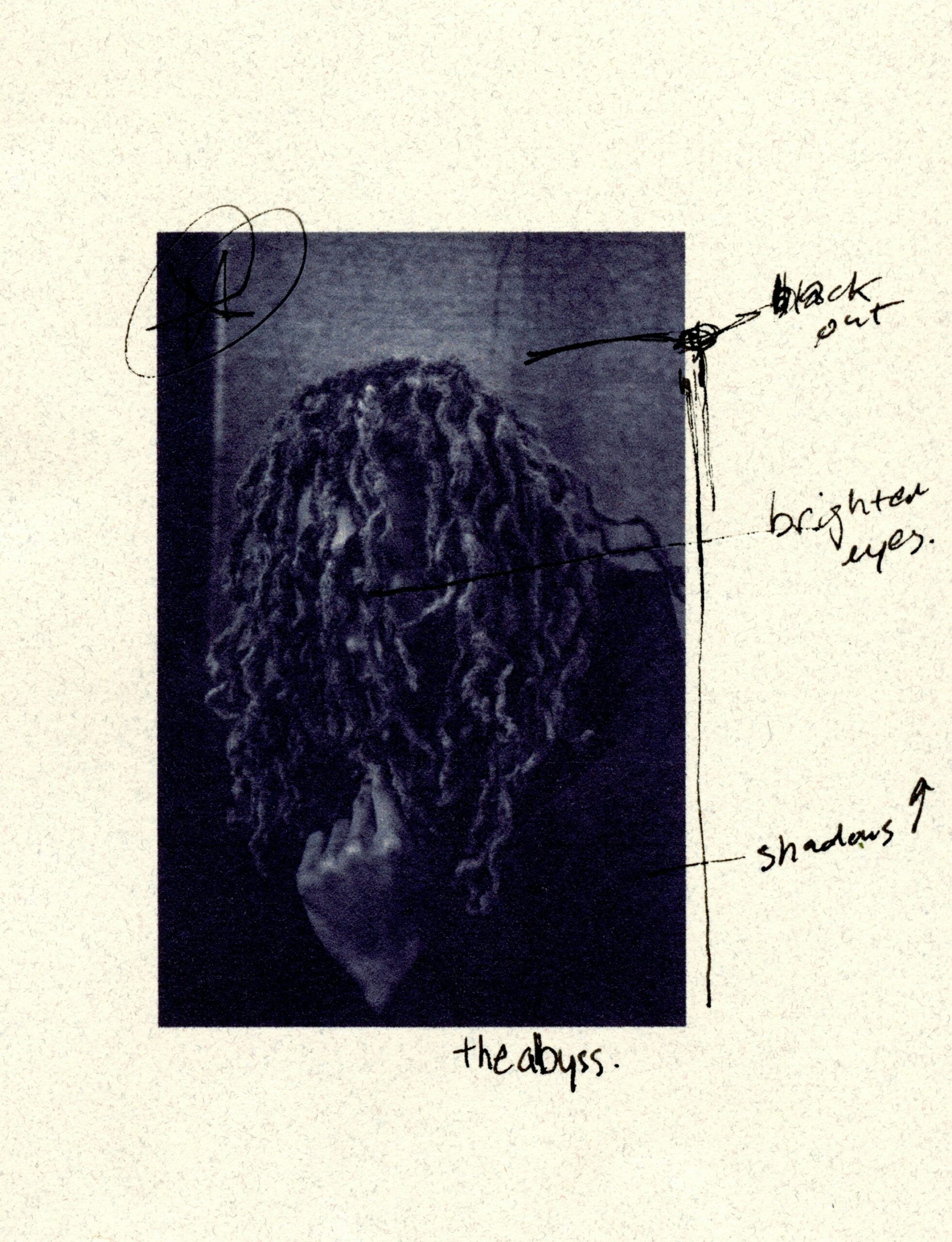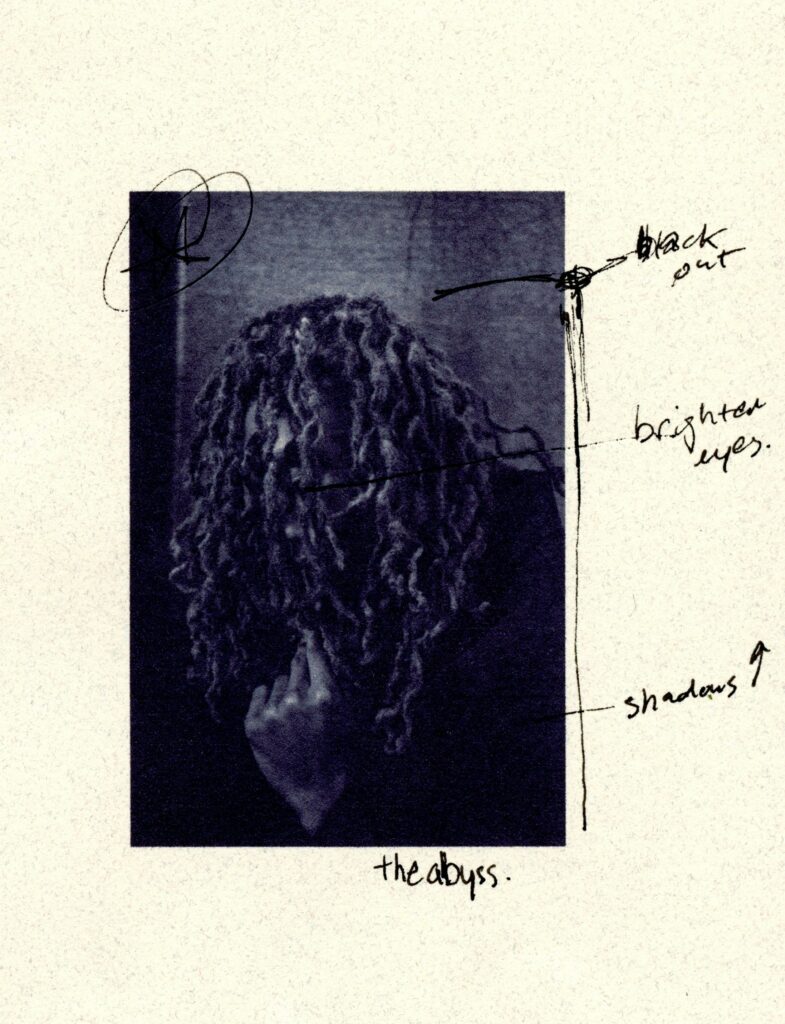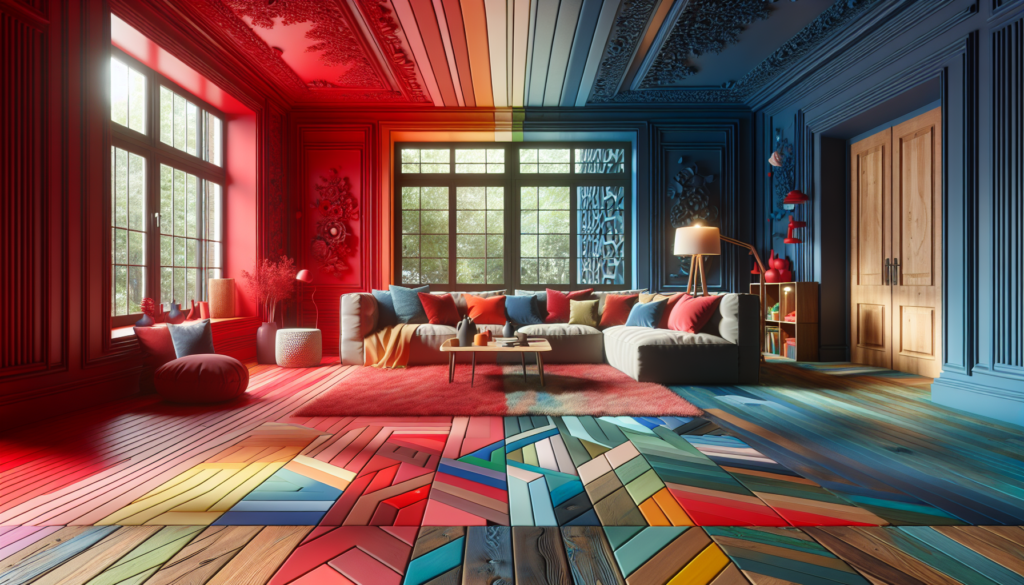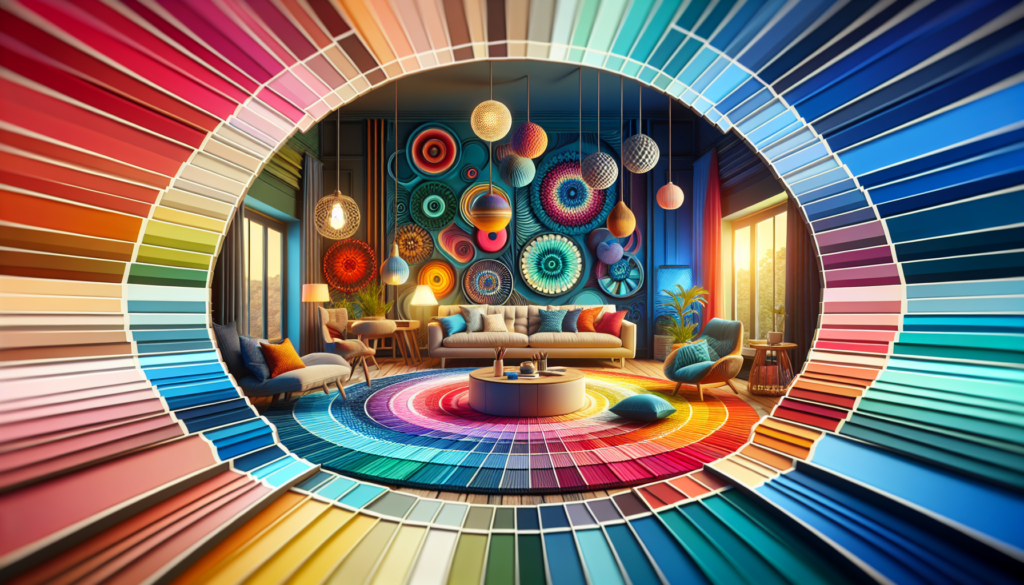
Imagine walking into a room with vibrant red walls. Almost instantly, you feel a surge of energy and excitement. Now, picture another room with calming blue hues, where you feel a sense of tranquility and relaxation wash over you. These scenarios demonstrate the profound impact that color can have on our emotions and well-being, particularly when it comes to home design. In this article, we will explore the fascinating realm of color psychology in home design and delve into the different ways that colors can influence our moods, behaviors, and overall experiences within our living spaces.

Color Psychology in Home Design
When it comes to designing your home, color plays a crucial role in creating the right atmosphere and enhancing the overall aesthetic appeal. Understanding the basics of color psychology can help you make informed choices and create a space that truly reflects your personality. In this article, we will explore the impact of color on mood and emotions, how it affects the perception of space, and provide insights on choosing the right colors for different rooms.
Understanding the Basics of Color Psychology
Color psychology is the study of how colors affect human behavior, emotions, and mood. Different colors have the power to evoke various feelings and can influence our perception of space. It is important to note that individual experiences, cultural backgrounds, and personal preferences can also impact our response to different colors.
The Impact of Color on Mood and Emotions
Choosing the right colors for your home can help create a harmonious and inviting environment. Warm colors such as red, orange, and yellow tend to stimulate energy and excitement. These colors are often associated with warmth, passion, and creativity. On the other hand, cool colors like blue, green, and purple have a calming effect and can promote relaxation and tranquility. Understanding the psychological effects of warm and cool colors can help you create the desired atmosphere in each room.
How Color Affects Perception of Space
Color can also play a significant role in how we perceive space. Lighter colors tend to make a room appear larger and more spacious, while darker colors can create a cozier and intimate feel. By strategically choosing colors, you can manipulate the perception of space in your home. Whether you live in a small apartment or a spacious house, understanding the impact of color on perception can help you make the most of your space.
Choosing Colors for Different Rooms
Different rooms in your home serve different functions, and the color choices should align with the purpose of each space. Let’s explore the ideal color choices for various rooms to create the desired atmosphere.
Bedroom Colors for Better Sleep
The bedroom is a space for relaxation and sleep, so it’s essential to choose colors that promote a restful environment. Soft, muted tones such as light blues, lavender, and neutral shades like beige or pale gray can create a soothing atmosphere. These colors can help calm the mind and prepare you for a good night’s sleep.
Living Room Colors for Relaxation and Socializing
The living room is often the main gathering space for family and friends. It should be inviting, comfortable, and suitable for relaxation and socializing. Warm earth tones like beige, brown, or warm gray can create a cozy and welcoming ambiance. Mix in some pops of color with throw pillows or artwork to add visual interest and liveliness to the room.
Kitchen Colors for Appetite Stimulation
The kitchen is often considered the heart of the home, and the choice of colors can influence our appetite and enjoyment of meals. Warm colors like red, orange, or yellow can stimulate the appetite and create an energetic and lively atmosphere. Consider incorporating these colors in accents such as backsplash tiles or kitchen accessories.
Bathroom Colors for Calm and Serenity
The bathroom is a place where we seek relaxation and rejuvenation. Soft pastel shades like pale blue, light green, or soft gray can create a spa-like ambiance, promoting calmness and serenity. These colors can make your bathroom feel like an oasis of tranquility.
Home Office Colors for Productivity and Focus
When it comes to your home office, productivity and focus are key. Opt for colors that inspire concentration and creativity. Shades of blue and green can provide a sense of tranquility and enhance focus. Avoid overly vibrant colors that may cause distractions and instead choose softer, muted tones for a harmonious work environment.
Children’s Room Colors for Creativity and Playfulness
Children’s rooms are a great opportunity to incorporate vibrant and playful colors. Bright primary colors like red, yellow, and blue can stimulate creativity and imagination. However, it’s important to strike a balance and create a soothing environment for bedtime. Consider using these colors as accents rather than overwhelming the entire room.
Warm Colors vs. Cool Colors
Understanding the psychological effects of warm and cool colors is essential in creating a harmonious balance in your home. Let’s dig deeper into the impact of these color categories.
Psychological Effects of Warm Colors
Warm colors such as red, orange, and yellow can evoke feelings of happiness, energy, and warmth. They tend to be stimulating and can create a cozy and intimate atmosphere. Warm colors are excellent for communal spaces like living rooms or dining areas, where social interaction and lively conversations take place.
Psychological Effects of Cool Colors
Cool colors like blue, green, and purple have a calming effect and can promote relaxation and tranquility. These colors are often associated with nature and health, making them suitable for bedrooms or spaces where you want to unwind and rejuvenate. Cool colors can also create a sense of spaciousness and make smaller rooms appear more open and airy.
Creating Balance and Harmony with Warm and Cool Colors
When it comes to incorporating warm and cool colors in your home, finding the right balance is crucial. Using contrasting colors, such as pairing a warm-toned accent wall with cool-toned furniture, can create visual interest and a harmonious environment. Experiment with different combinations to achieve the desired effect in each room.
Color Combinations and Effects
The choice of color combinations in your home can greatly affect the overall mood and visual impact. Let’s explore various color schemes and their effects on the space.
Complementary Colors and Their Impact
Complementary colors are opposite each other on the color wheel, such as red and green or blue and orange. When used together, these colors create a vibrant and dynamic contrast. Complementary color schemes can add energy and liveliness to a room, making them suitable for areas where you want to make a bold statement, such as a dining room or an accent wall.
Analogous Colors and Their Effect on Mood
Analogous colors are adjacent to each other on the color wheel, such as blue, green, and teal. Using analogous colors creates a sense of harmony and continuity in a space. These color schemes are versatile and can create a calm and soothing ambiance. Analogous colors are often used in bedrooms, bathrooms, or any space where relaxation is desired.
Using Monochromatic Color Schemes for a Cohesive Look
Monochromatic color schemes involve using different shades and tints of a single color. This creates a cohesive and harmonious look in a room. The use of varying intensities of one color adds depth and visual interest, without overwhelming the space. Monochromatic color schemes are commonly used in minimalist or contemporary designs.
Triadic Color Scheme and Its Vibrant Energy
A triadic color scheme involves using three colors that are evenly spaced on the color wheel, such as purple, orange, and green. This creates a vibrant and energetic environment, perfect for spaces where creativity and excitement are desired, such as playrooms or art studios. However, it’s essential to use these colors in moderation to avoid overwhelming the room.

The Influence of Neutrals and Whites
While colors play a significant role in home design, neutrals and whites hold their own unique power. Let’s explore their psychological effects and how to incorporate them effectively.
Psychological Effects of Neutrals
Neutrals like beige, gray, and brown can create a sense of calmness and timelessness. They serve as a neutral backdrop, allowing other elements in the room to stand out. Neutrals are often associated with sophistication and elegance, making them popular choices for living rooms and bedrooms.
The Power of White in Home Design
White is a versatile color that symbolizes purity, simplicity, and cleanliness. It reflects light and can make a space feel larger and more open. White walls and furniture can create a minimalist and contemporary look. However, be cautious as too much white can feel clinical, so consider adding colorful accents or textures to balance the space.
Combining Neutrals and Whites with Accent Colors
Neutrals and whites provide an excellent canvas to incorporate accent colors. By adding pops of color through accessories, artwork, or furniture, you can create visual interest and inject personality into the room. Accent colors can provide a refreshing contrast to neutrals and whites, making the space more vibrant and lively.
Color Psychology for Small Spaces
If you have a smaller home or specific rooms that are compact, understanding color psychology can help you maximize the perceived space. Here are some tips to create the illusion of space and enhance the visual appeal.
Creating the Illusion of Space with Light Colors
Light colors, especially whites and pastels, can make a small space feel more open and airy. These colors reflect light and create an optical illusion of a larger area. Opt for light-colored walls, floorings, and furniture to make the space appear more spacious. Avoid using dark colors that can shrink the perception of the room.
Using Bold Colors and Patterns for Visual Interest
While light colors are generally preferable for small spaces, don’t shy away from using bold colors and patterns strategically. Adding pops of color through accent walls, colorful furniture, or vibrant patterns can draw the eye and create visual interest. Just ensure not to go overboard, as too many bold elements can make the space feel cluttered.
Strategic Placement of Mirrors and Reflective Surfaces
Mirrors and reflective surfaces can work wonders in small spaces. They create an illusion of depth and bounce light around the room, making it appear larger and brighter. Consider placing a large mirror opposite a window to reflect natural light, or strategically position mirrored furniture to add depth to the space.

Cultural and Personal Associations of Colors
Colors hold cultural and personal meanings that can influence how we perceive them. Understanding these associations can help you create a personalized and meaningful home design.
Understanding Cultural Symbolism of Colors
Different cultures associate colors with various meanings and symbolisms. For example, in Western cultures, white is often associated with purity and weddings, while it may represent mourning in some Eastern cultures. Research the cultural symbolism of colors that resonate with you and incorporate them into your home design to honor your heritage or personal beliefs.
Personal Preferences and Color Personality Traits
Each individual has unique color preferences, often influenced by personal experiences and personality traits. Some people may feel energized by vibrant colors, while others may find solace in soothing pastels. Consider your own color preferences and how they align with your desired mood and atmosphere for each room in your home.
Integrating Cultural and Personal Meanings in Home Design
Incorporating cultural and personal meanings of colors can add depth and personalization to your home design. Whether it’s using cultural artifacts or artworks that celebrate your heritage or selecting colors that evoke certain emotions or memories, these elements can make your home feel more meaningful and reflective of your identity.
The Effects of Color on Homebuyers
When selling a home, the choice of colors can significantly impact potential buyers’ perception and interest. Here are some considerations to keep in mind.
Neutral Colors for Real Estate Market Appeal
Neutral colors are often recommended when staging a home for sale. They have broad market appeal because they create a clean and blank canvas for potential buyers to envision their own style and preferences. Opt for beige, light gray, or soft pastel shades to create a neutral backdrop that appeals to a wider range of buyers.
Attracting Buyer’s Attention with Accent Colors
While neutral colors play a safe role in attracting potential buyers, strategically placed accent colors can create visual interest and make your home stand out from other listings. Consider using accent colors in accessories, artwork, or even a statement piece of furniture to add personality and make an impact.
Avoiding Overwhelming or Off-Putting Color Choices
When selling a home, it’s essential to avoid color choices that may be too overwhelming or off-putting to potential buyers. Bold or vibrant colors may polarize opinions and limit the market appeal. It’s best to stick to neutral colors in main living areas and reserve bolder colors for accents or personal spaces.

Color Psychology in Home Staging
Home staging is a crucial aspect of preparing a property for sale. Color psychology can play a significant role in creating a welcoming and balanced environment for potential buyers.
Creating a Welcoming and Balanced Environment
The goal of home staging is to create a warm and inviting atmosphere that appeals to a wide range of buyers. Use warm, neutral colors like beige or light brown to create a comfortable and cozy environment. Consider adding tasteful accent colors through accessories, artwork, or strategically placed furniture to add visual interest without overwhelming the space.
Using Color Psychology to Highlight Room Functionality
Color choices can also be used to emphasize the functionality of each room. For example, using calm and soothing colors in the bedroom can highlight it as a place for relaxation and rest. Similarly, a vibrant and energetic color scheme in a home office can emphasize productivity and creativity.
Appealing to the Target Demographic with Colors
When staging a home, it’s important to consider the target demographic. Research the preferences and color trends for the specific target market to tailor your color choices accordingly. Younger buyers may gravitate towards more modern and vibrant colors, while older buyers may prefer classic and timeless hues. Understanding the demographic can help you create a design that resonates with potential buyers.
The Role of Color Consultation in Home Design
Choosing the right colors for your home can be a daunting task. Working with a professional color consultant can make the process easier and ensure you achieve the desired atmosphere and aesthetic. Here are some benefits of color consultation and what to expect from the process.
Benefits of Consulting a Professional Color Expert
Color consultants are trained professionals who understand the nuances of color psychology and its impact on design. They can provide expert guidance, helping you select the right colors for each room, taking into consideration factors such as lighting, architectural features, and personal preferences. Working with a professional can save you time, money, and help you create a cohesive and visually appealing home.
Customizing Color Palettes to Suit Individual Preferences
Color consultants take into account your individual preferences, lifestyle, and needs when creating custom color palettes. They can guide you through the process, ensuring that the colors chosen align with your vision and personality. By customizing color palettes, you can create a truly personalized and unique home.
The Process of Color Selection and Coordination
During a color consultation, the consultant will assess your space, discuss your goals, and walk you through the color selection process. They will help you choose colors that align with the function of each room, create the desired mood, and complement the overall design scheme. The consultant will also consider factors such as lighting, natural flow between spaces, and the relationship between colors in different rooms to ensure a cohesive look throughout your home.
In conclusion, understanding color psychology is invaluable when it comes to designing your home. By considering the impact of colors on mood and emotions, perception of space, and cultural associations, you can create a space that not only looks visually appealing but also promotes the desired atmosphere and reflects your personality. Whether you choose warm or cool colors, explore different color combinations, or integrate neutrals and whites, the right color choices can transform your home into a harmonious and inviting sanctuary. And if you find the task of selecting colors overwhelming, consider consulting a professional color expert who can help you navigate the process and bring your vision to life.

